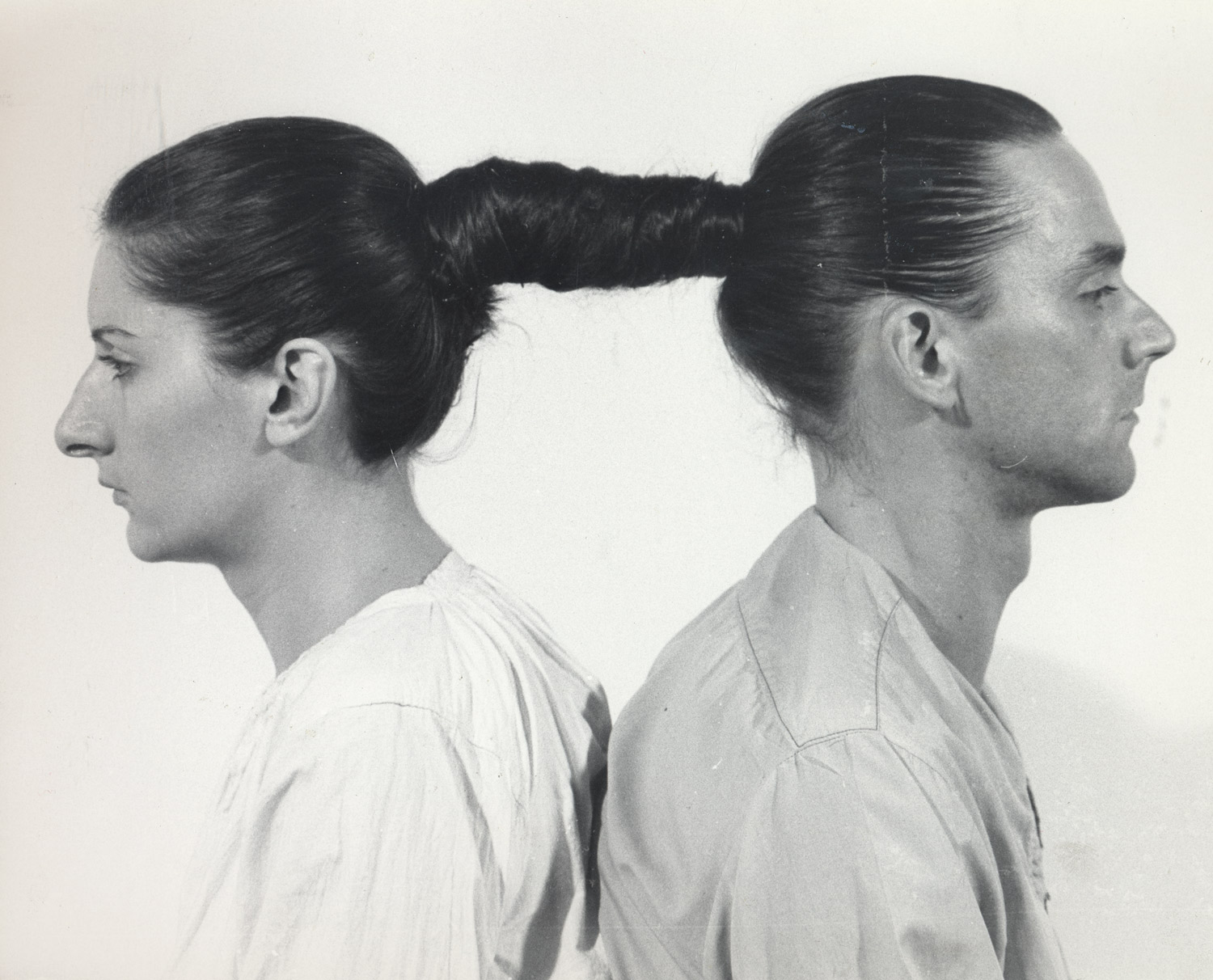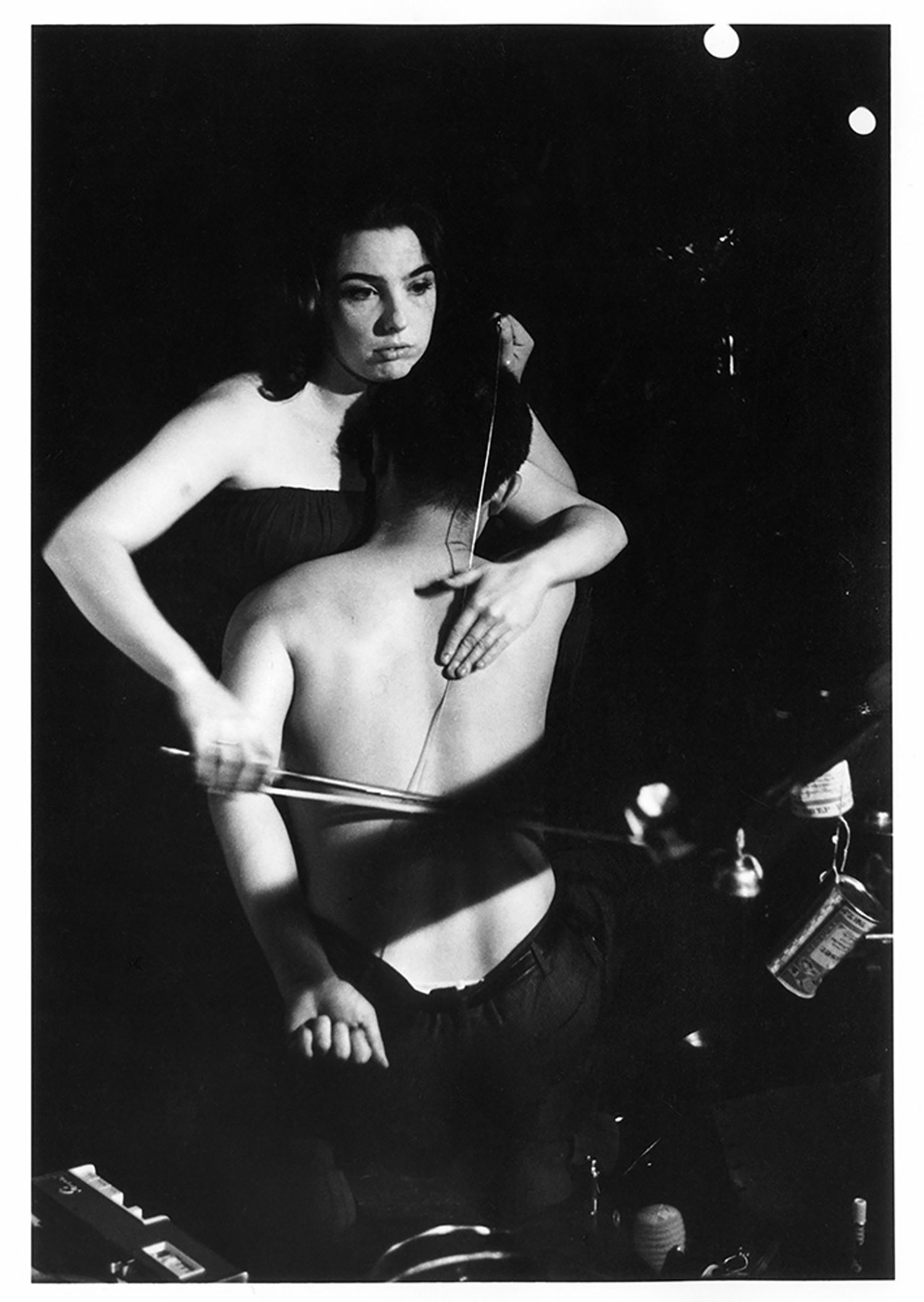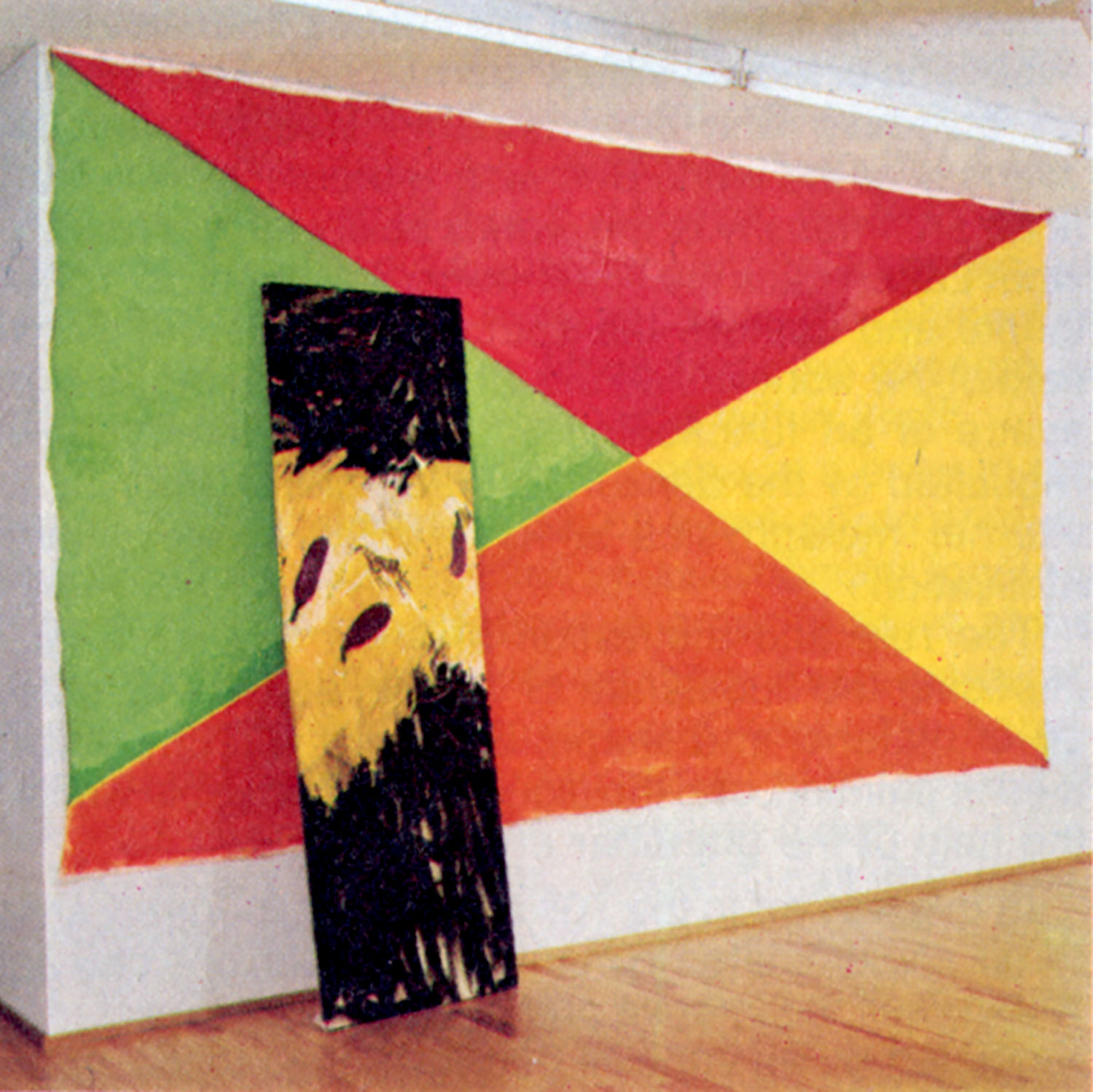Flash Art mourns the loss of Germano Celant, critic, curator, theorist of the term “Arte povera”, of which the manifesto ‘Notes on a guerrilla war’ was first published on the pages of Flash Art in 1967. Celant was a pivotal figure in the shaping of the thought about contemporary art, each exhibition he curated was a statement: from the historic collective exhibition “Arte povera – Im Spazio” in 1967 at La Bertesca gallery, to “Italian Metamorphosis 1943-1968” at the Guggenheim, to his latest iterations at the Prada Foundation, including the 2013 remake of “When Attitudes Become Form” in Venice, formerly curated by Harald Szeemann in 1969. Today Flash Art remembers him by publishing a transcription of his “Arte Povera. Notes on a guerrilla war” published in Flash Art no. 5 November–December 1967. The art world will deeply miss him.

First comes the human being and then the system, or that’s how it was in antiquity. Today, however, society presumes to make pre-packaged human beings, ready for consumption. Anyone can propose reform, criticize, violate, and demystify, but always with the obligation to remain within the system. It is forbidden to be free. Once you create an object, you always have to remain by its side. That’s what the system commands. This expectation is never to be frustrated, and once an individual has assumed a role, he has to continue to perform it until death. Each of his gestures has to be absolutely consistent with his behavior in the past and has to foreshadow his future. To exist from outside the system amounts to revolution.
The artist, the new apprentice jester, is thus called upon to produce fine commercial merchandise, offering satisfaction to sophisticated palates. Once he has an idea, he has to live for it and on it. Mass production mentality forces him to produce a single object that satisfies the market to the point of saturation. He is not allowed simply to create the object and then to abandon it to its destiny. He has to follow up on it, justify it, introduce it into the channels of distribution, turning himself as artist into a substitute for an assembly line. No longer a stimulator, technician, or specialist of discovery, he becomes a cog in a mechanism. His behavior is conditioned into never offering more than a ‘correction’ to the world, perfecting its social structures but never modifying or revolutionizing them. Even though he rejects consumer society, he discovers himself one of its producers. Freedom is an empty word. The artist ties himself down to history, or rather to a program, and exists from the present. He never creates a project, and seeks only integration. In order to ‘invent,’ he is forced to act like a kleptomaniac and to serve himself at the font of the other linguistic systems. But what was Marcel Duchamp all about? Certainly he wasn’t interested in satisfying the system. Existence, as far as he was concerned, could only mean, and continues to mean, to play the game of chess (where the knight never moves in straight lines) and to make his own choices, never waiting simply to be chosen. The system tried several times to seek him out, but he was never to be found where the system expected to find him.
In a context dominated by technological inventions and imitations, one finds oneself faced by one of two choices: either a kleptomaniac reliance on the system and the use of codified and artificial languages in comfortable dialogue with existing structures, both social and private, the acceptance of ideology and its pseudo-analyses, an osmosis into all the apparent revolutions that are immediately reabsorbed, the subordination of one’s work to the abstract (op) microcosm or to the socio-cultural (pop) and formal (primary structures) macrocosm; or, entirely at the other extreme, an option for free and individual self-development.
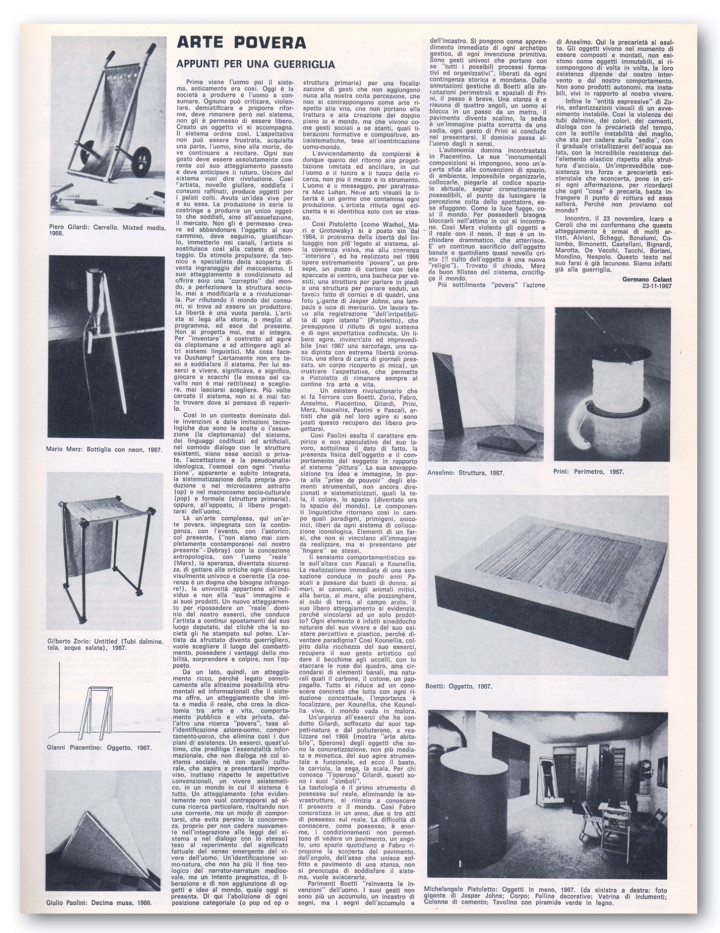
Over there a complex art, over here a poor art, committed to contingency, to events, to the non-historical, to the present — “we are never entirely the contemporaries of our present” (Jules Régis Debray), to an anthropological viewpoint, to the ‘real’ man (Karl Marx), and to the hope (in fact now the certainty) of being able to shake entirely free of every visual discourse that presents itself as univocal and consistent. Consistency is a dogma that has to be transgressed, and the univocal belongs to the individual and not to ‘his’ images and products. A new attitude for taking repossession of a ‘real’ dominion over our existence leads the artist towards continual forays outside of the places assigned to him, eradicating the cliché that society has stamped on his wrist. No longer among the ranks of the exploited, the artist becomes a guerrilla fighter, capable of choosing his places of battle and with the advantages conferred by mobility, surprising and striking, rather than the other way around.
So on the one hand, we have an attitude to be defined as ‘rich’ since it is osmotically connected to the enormous instrumental and informational possibilities that the system offers; an attitude that imitates and mediates the real creates the dichotomy between art and life, public behavior and private life. And on the other hand, we have ‘poor’ research, intent upon the identification of the individual in his actions, of the individual in his behavior, thus eliminating all separation between these two levels of existence. This is a way of being that asks only for essential information, that refuses dialogue with both the social and the cultural systems, and that aspires to present itself as something sudden and unforeseen with respect to conventional expectations: an asystematic way of living in a world where the system is everything. Such an attitude (which obviously doesn’t see itself in contrast to any particular form of research, since rather than a school it is a way of behavior and even committed to the avoidance of competition so as not once again to fall into an integration, into the laws of the system or into any kind of dialogue with it) — such an attitude is intent upon retrieving the factual significance of the emerging meaning of human life. It’s a question of an identification between man and nature, but with none of the theological purposes of the medieval narrator-narratum; the intention, quite to the contrary, is pragmatic, and the goal is liberation, rather than any addition of ideas or objects to the world as it presents itself today. Hence, there’s an abolition of all positions couched in terms of categories (either “pop” or “op” or “primary structures”) in favor of a focalization of gestures that add nothing to our refinements of perception, that don’t contrapose themselves as art to life, that don’t lead to the fracture and creation of two different planes of the ego and the world, and that live instead as self-sufficient social gestures, or as formative, compositive, and antisystematic liberations, intent upon the identification of the world and the human individual.
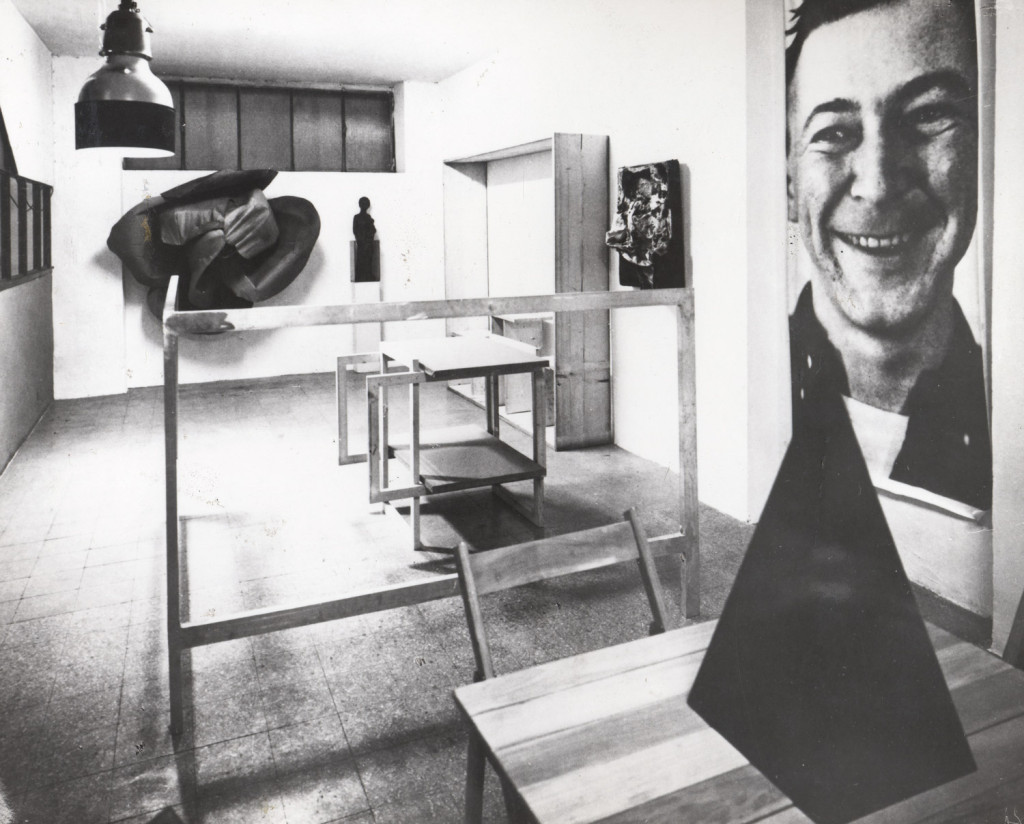
The shift that has to be brought about is thus the return to limited and ancillary projects where the human being is the fulcrum and the fire of research, in replacement of the medium and the instrument. The man is the message, to paraphrase Marshall McLuhan. Freedom, in the visual arts, is an all-contaminating germ. The artist refuses all labels and finds identification only with himself.
Ever since 1964, Michelangelo Pistoletto (like Andy Warhol, Enzo Mari, and Jerzy Grotowski) has thus given himself over to the problem of a freedom of language no longer connected to the system or to any kind of visual consistency; he’s concerned, instead, with ‘interior’ consistency, and in 1966 he produced a series of extremely ‘poor’ works: a Christmas manger, a cardboard well with torn canvas at its center, a showcase for clothing, a structure for conversing standing up and a structure for conversing sitting down, a table made of picture frames and paintings, a giant-sized photograph of Jasper Johns, and a mercury light. This work is committed to the registration of “the irrepeatability of every instant” (Pistoletto), and it presupposes the rejection of any and all systems and of all codified expectations. A free mode of action, unforeseeable and without restraints (in 1967, a sarcophagus, a house painted with great chromatic freedom, a sphere of compressed newspaper, a body covered with mica) and franchised to frustrate expectations, which allows Pistoletto always to straddle the borderline between art and life.
This revolutionary way of existence turns into the Reign of Terror with Boetti, Zorio, Anselmo, Piacentino, Gilardi, Prini, Merz, Kounellis, Paolini and Pascali, all of whom are artists whose modes of action pose the problem of this recovery of free self-determination.
Paolini thus emphasizes the empirical rather than the speculative nature of his work, underlining the factual given, the physical presence of the object, and the behavior of the individual with respect to the system of painting. His superimpositions of idea and image lead him to a prise de pouvoir with respect to such elementary instruments (not yet directioned or systemized) as canvas, color, and space (which becomes by now the space of the world). The linguistic components of painting thus return into the field as primary, aniconic paradigms, free from every system of iconological collocation. They are elements of a self-construction never enchained to the image to be realized, and they present themselves instead as ‘imitations’ of themselves.
With Pino Pascali and Jannis Kounellis, a sensuality of behavioral orientations steps up onto the altar. The immediate realization of sensations has led Pascali, in the course of just a few years, to pass from female torsos to walls, cannons, mythical animals, boats, the sea, puddles, blocks of earth and plowed fields. His free-wheeling attitude is clear, and why should he tie himself down to any one product? Each of the elements he touches is in fact a natural synecdoche of his whole life process and of his perceptual and plastic sensibility, so why should it become a paradigm? It is much the same with Kounellis; struck by the richness of his existence, he recuperates artistic gesture in feeding bird food to birds, in detaching roses from a painting, and he loves to surround himself with banal but natural objects like coal, cotton, or a parrot. Everything is reduced to a concrete knowledge that struggles against all conceptual reductions of itself, and the important thing for Kounellis is to focus on the fact that Kounellis is alive and the rest of the world can go to hell.
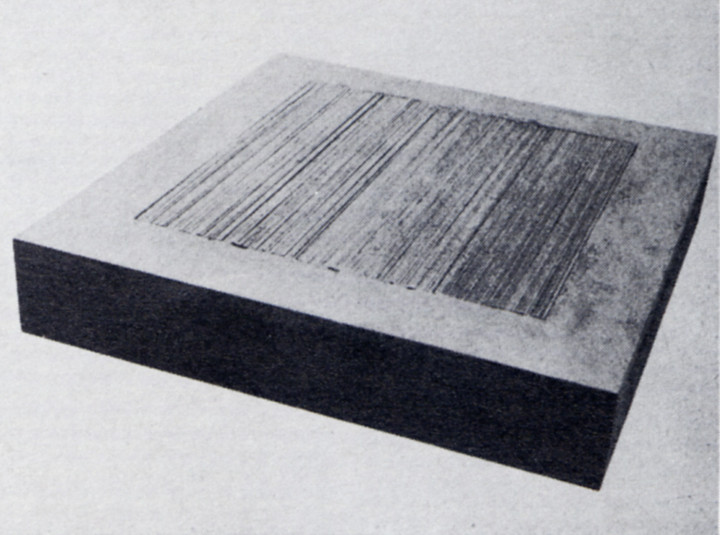
Suffocated by the polyurethane of his ‘nature-carpets,’ Piero Gilardi became aware of existential urgency that led him, in 1966 (the ‘inhabitable art’ exhibition with Gian Enzo Sperone), to the realization of objects that are no longer a mediated or mimetic concretization of his functional and instrumental modes of behavior: we find ourselves faced with his pack-saddle, his wheelbarrow, his saw, his ladder. For those who know an ‘operative’ Gilardi, these are his symbols.
Tautology is the first instrument for taking possession of the real, since it’s through the elimination of superstructures that one begins again to have awareness of the present and of the world.
Luciano Fabro, in the course of a year, is thus to be seen performing two or three acts that take possession of reality. The difficulty of knowledge, or of taking possession of things, is enormous: conditioning prevents us from seeing a pavement, a corner, or a daily space, and Fabro reproposes the rediscovery of a pavement, a corner, or the axis that unites the floor and ceiling of a room. He’s not worried about satisfying the system, and intends instead to disembowel it.
In much the same way, Alighiero Boetti reinvents the inventions of human beings. His gestures are no longer an accumulation or an interweaving of signs, but the signs of accumulation and of interweaving. They posit themselves as an immediate understanding of every gestural archetype, and of every primitive invention. They are univocal gestures that comport “all the possible formative and organizational processes,” freed of all historical or social contingencies. And it’s only a short step from Boetti’s gestural annotations to the parametrical and spatial annotations of Emilio Prini. A room is, and resounds with, four corners, a man remains blocked in a meter-long stride, a floor turns into stairs, a chair is a flat image; each of Prini’s gestures concludes by simply presenting itself. Dominion becomes the prerogative of the man with ‘n’ senses.
Autonomy holds unchallenged mastery with Gianni Piacentino. His ‘monumental’ compositions impose themselves as an open challenge to the conventions of space and ambientation. It’s impossible to reorganize them, to collocate them, or to bend them to any habitual spatial code; in spite of their making themselves chromatically available, even to the point of flattering the refinement of the viewer’s perceptions, they finally flee away from us. Just as light flees, or the world itself. If we want to possess such things, we have to call them to a halt in the very moment we encounter them. Mario Merz thus violates objects and reality with neon tubings. He has a dramatic and frightening way of nailing things down. He performs a constant sacrifice of the banal, everyday object, as though it were a newfound Christ (the cult of the object is a new religio). Having found his nail, Merz becomes the system’s philistine and crucifies the world.
The ‘poverty’ of Giovanni Anselmo’s action is more subtle. Precariousness is what calls itself to attention here. His objects live within the moment in which they are composed and assembled and have no existence as immutable objects. To re-exist, they have to be re-composed, which means that their existence depends upon our interventions and behavior. Rather than autonomous products, they are unstable, and alive in relationship with our own lives.
Finally, there are Gilberto Zorio’s expressive entities, as visual emphaticizations of an unstable event. Thus the violence of his scaffold tubing, pigments and cements dialogs with the precariousness of time, with the subtle instability of the grille that’s about to fall onto the chair, with the slow crystallization of the salt water, with the incredible resistance of elastic cords in relationship to a structure in steel. This makes for a disconcerting coexistence of brute force and existential precariousness, thus undermining the very possibility of all affirmations and reminding us that every ‘thing’ is precarious: it’s enough to act against its breaking point and it will inevitably collapse. Why don’t we try it with the world itself?
Today, November 23, 1967, I run into Icaro and Ceroli and they confirm that these attitudes are now the common property of any number of artists: Alviani, Scheggi, Bonalumi, Colombo, Simonetti, Castellani, Bignardi, Marotta, De Vecchi, Tacchi, Boriani, Mondino, Nespolo. Gaps find their way into the text even while it is getting itself written. The guerrilla war, in fact, has already begun.


